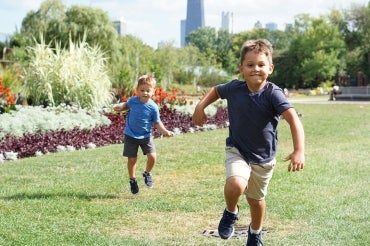Boys identify more strongly with their peers than others: U of T study

Published: November 15, 2018
Trying to get your teenage boys to behave at the dinner table? Chances are they will respond better if you get one of their peers to model the behaviour for them, according to a new study from researchers at the University of Toronto.
The study, published recently in the Cognitive Development journal, looks into how children and youth engage in “self-other matching” – the ability to look at another person’s body and relate it to an understanding of their own body.
“For example, when we attempt to imitate someone else’s action, such as how they are standing or walking, we need to first identify the other person’s body parts – the arms, legs, head, etc. Then, we need to conceptually map those body parts to our own body parts and match the positions and motions of the other person’s body parts to those of our own body,” explains Timothy Welsh, a professor in the Faculty of Kinesiology & Physical Education who co-authored the study with Associate Professor Luc Tremblay, and graduate students Sandra M. Pacione, Shikha Patel and Aarohi Pathak of the faculty's Centre for Motor Control.
The researchers hope the study will lead them to a greater awareness of how people with and without neurological or social disorders interact socially.
“Because this ‘self-other matching’ process is thought to be one core step in social interactions like empathy and observational learning, more effective self-other matching with peers might help us understand more about how we interact with and learn from people we consider to be peers and non-peers,” says Welsh.
The researchers found that the matching process was strongest when the children and youth looked at the bodies of their peers. For example, boys aged 10 to 12 engaged in “self-other matching” when they saw an image of 11-year-old boy, but not so much when they were shown pictures of a seven-year-old boy and a 15-year-old boy.
This age component surprised the researchers, who had assumed that because people interact with those in all stages of life, age wouldn’t be an issue. “It’s not that children and youth are incapable of self-other matching with non-peers, but it does seem that this self-other matching process is most effective with peers,” says Welsh.
Curiously, there was no evidence of self-other matching for girls in the study. The researchers attribute this finding to the fact that youth participating in the study were only given images of boys to view. Boys were the focus of the study because the research was designed as the start of a series of future studies of people with neurological disorders, such as autism, which tend to be more common in boys than girls. Nonetheless, this result may indicate some cross-gender considerations that require additional research, according to Welsh.
Teachers, coaches and parents may want to take special note of the results of the study. “If you are trying to teach someone a new behaviour or movement by having the person model and imitate those movements of another person, it could be that this modelling and learning might be more effective if a peer is the model,” says Welsh.
“This is not to suggest that people cannot learn by watching anyone, whether they are a peer or not, only that the learning might be more effective when we can easily match the body we observe onto our own body.”
The research was supported by the Natural Sciences and Engineering Research Council of Canada (NSERC), the Social Sciences and Humanities Research Council of Canada (SSHRC) and the Ontario Ministry of Research and Innovation.



